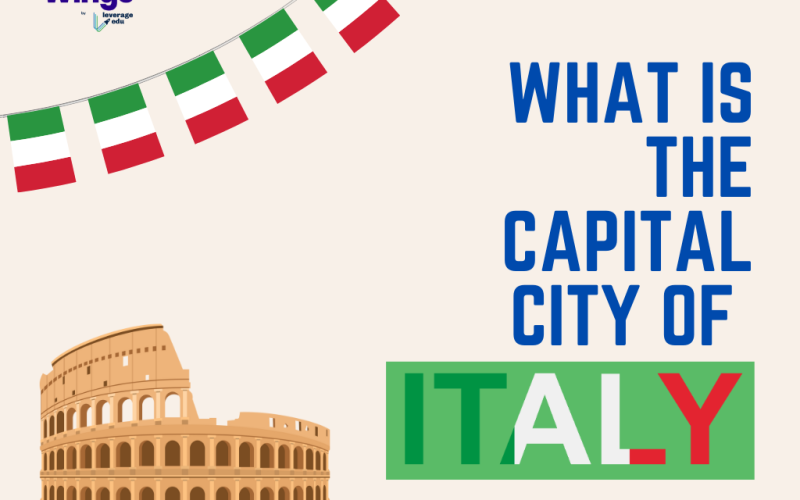Rome, the Eternal City is the capital city of Italy. Located on the Tiber River on the country’s central peninsula, it has a rich history. Though it became the capital in 1860, Rome’s significance stretches way back in time. It served as the heart of the Roman Kingdom, Republic, and Empire, leaving behind a legacy of architecture and cultural influence. Today, Rome remains a political and cultural powerhouse, attracting millions with its iconic landmarks, Vatican City, and vibrant energy. Read this blog to learn more about “What Is the Capital City of Italy?”
Table of Contents [show]
Also read: What is the Capital City of West Bengal?
Overview Of The Capital City Of Italy
The capital city of Italy, Rome, is highly influential and has a long ancient history
- Rome is nicknamed “The Eternal City” which reflects its history from a small settlement on the Tibet River to becoming the capital of the Roman Empire.
- The capital city of Rome has a lot of influence across Europe and North Africa.
- The Colosseum amphitheater, which was built in the 1st century AD is an iconic symbol of Rome.
- Vatican City, home to the Catholic Church’s headquarters and the smallest sovereign state in the world, is located in Rome.
- The monumental “Spanish Steps” stairs, leading from Piazza di Spagna to Trinità dei Monti church, are a popular gathering spot and offer stunning views of the city.
- The Piazza Navona is a lively square that has a captivating central fountain designed by Bernini.
History Of The Capital City Of Rome
The history of Rome dates back to a long ancient period and spans around two and a half millennia.
- It is an ongoing myth that Rome was founded by Romulus and Remus around 753 BC.
- Before the Roman Republic, the city was influenced by the Etruscans, a powerful civilization in central Italy. Their engineering and political structures laid the groundwork for Roman development.
- Rome was established as a republic in 509 BC after overthrowing the Etruscan monarchy and this period saw a huge expansion and development of the Roman Law.
- Following Julius Caesar’s rise and civil wars, Rome transitioned into a vast empire (27 BC – 476 AD)
- The Colosseum, built during the empire, stands as a symbol of Rome’s power and entertainment culture. It hosted gladiatorial contests, public executions, and animal hunts.
- With its rise, the city saw a rise in Christianity.
- However, early Christians faced persecution but eventually became the dominant religion, shaping Rome’s cultural landscape.
- From the 14th to 16th centuries, Rome witnessed a cultural and artistic revival, known as the Renaissance.
- In the 19th century, Italian unification movements aimed to make Rome the capital of a united Italy.
- In 1870, Rome was finally captured and became Italy’s capital.
Demography And Geography Of Rome
The Capital City of Italy, Rome, is very strategically located in central Italy.
- Rome, the capital of Italy, has a very strategic location near the Tiber River and the Mediterranean Sea which has facilitated trade.
- Rome’s historic center is built on seven hills, offering a unique topography and influencing the city’s layout.
- The seven hills surrounding the Rome region are Palatine, Capitoline, and Aventine.
- Rome enjoys warm, dry summers and mild, wet winters. This climate is ideal for agriculture and outdoor activities
- Even in its early days, Rome was a relatively large and densely populated city. The development of infrastructure and centralized government attracted people.
- Today, Rome is the most populous city in Italy with over 4 million residents.
- The city has a rich mix of ethnicities due to immigration throughout history and recent times.
- Rome has a well-developed transportation network, including an international airport, trains, and a metro system. This allows for easy access within the city and connections to other parts of Italy and Europe.
Also read: What is the Capital City of Haryana?
Culture and Economy Of Rome
Rome, the capital city of Italy has been a center of art and culture for centuries.
- From Renaissance masters like Michelangelo to contemporary artists, the city is still a hub of creativity.
- As the heart of the Catholic Church, Rome plays a major role in religious traditions.
- The presence of Grand churches, religious festivals, and the Vatican contributes to the city’s cultural landscape.
- Rome is a major tourist destination, attracting millions of visitors each year.
- Rome is a major financial center in Italy, having banks, insurance companies, and other financial institutions.
- Since Rome is the capital city of Italy, it has a significant number of government jobs.
- Beyond traditional sectors, Rome is developing its technology and service industries, fostering innovation and attracting new businesses.
Also read: What is the Capital of Karnataka?
FAQs
In the Italian peninsula there are three capitals:
Rome: capital of the Republic of Italy.
San Marino: capital of the Republic of San Marino.
Vatican City: capital of the Vatican State.
Rome is nicknamed “The Eternal City” because of its long and rich history, dating back to ancient times, and its enduring cultural influence.
Some iconic landmarks in Rome include the Colosseum, Vatican City, the Spanish Steps, and the Piazza Navona.
Relevant Blogs
That is all about the Capital of Italy. If you want to know more about topics like this, then visit our general knowledge page!
 One app for all your study abroad needs
One app for all your study abroad needs















 45,000+ students trusted us with their dreams. Take the first step today!
45,000+ students trusted us with their dreams. Take the first step today!
